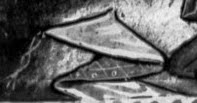Prüfening (Regensburg), 1170/1180.
A more heavily illustrated manuscript, with quite a few women illustrated, but no calf length tunics and no patterned fabrics.
Women in the manuscript:
I haven't included picture captions, as bildindex was unusually uninformative. (captions such as "Minature from Matthew")




 [28], [66v], [90], [140], [100v],
[28], [66v], [90], [140], [100v], Plain dress with flared sleeves, veil (or loose hair), some with rucked up chemise sleeves. The veils are probably wrap around ones - see how the 2nd image has a clear line across the shoulder where a wrap would cross itself, and the others have similar pattern of folds.


 [66], [66v], [82v], As above, but with beanie caps. The beanie caps are worn over the same veils as above or just over the hair (2nd lady, first image). Most have bands of trim around the edge. Some of them are a plain circle, others vee upwards on the forehead. Several here appear to be worn jauntily, slightly off centre on the head, but they could be ones with a vee where i can't see the second side clearly. The one's that don't vee remind me of Jewish skullcaps.
[66], [66v], [82v], As above, but with beanie caps. The beanie caps are worn over the same veils as above or just over the hair (2nd lady, first image). Most have bands of trim around the edge. Some of them are a plain circle, others vee upwards on the forehead. Several here appear to be worn jauntily, slightly off centre on the head, but they could be ones with a vee where i can't see the second side clearly. The one's that don't vee remind me of Jewish skullcaps. [90v] Veil is loosely draped - doesn't cover front of neck. Rest of dress same as others. This could be a man (i've seen such head drapes on people with beards), but I don't think so.
[90v] Veil is loosely draped - doesn't cover front of neck. Rest of dress same as others. This could be a man (i've seen such head drapes on people with beards), but I don't think so. [100v] Dress same as others, but she is wearing a turban. It's hard to tell with the smudge mark, but I think she is wearing the same wrap veil as the others (you can even see a dangling end behind her shoulder), and then the turban on top of that. It could be a pre-wrapped turban. Or it might be a different variety of hat I've not seen before, but I'm pretty sure I can see bands of wrapping. Her face appears to be contorted (big nose, fat face, scowl?) which may be a racial stereotype, or may just be me reading too much into a smudge mark. I should note my reasons for assuming this is a female - floor length dress and long maunches, features I haven't seen on guys before (ankle length, or longer with a slit, and only short maunches I have seen).
[100v] Dress same as others, but she is wearing a turban. It's hard to tell with the smudge mark, but I think she is wearing the same wrap veil as the others (you can even see a dangling end behind her shoulder), and then the turban on top of that. It could be a pre-wrapped turban. Or it might be a different variety of hat I've not seen before, but I'm pretty sure I can see bands of wrapping. Her face appears to be contorted (big nose, fat face, scowl?) which may be a racial stereotype, or may just be me reading too much into a smudge mark. I should note my reasons for assuming this is a female - floor length dress and long maunches, features I haven't seen on guys before (ankle length, or longer with a slit, and only short maunches I have seen).Image summary of remaining pages and rest of featured pages:
- [15v], [27v], [28], [55], [55v], [66], [81v], [82], [82v], [83], [90], [90v], [101], [120], [120v], [139v], [140] Men in tunics shorter than shirts, many bands of trim.
- [15v], [55], [55v], [82] stereotyped Jewish hat.
- [120v] guy in a beanie hat. With a knob on top.
- [15v] scalloped shaped belt like the ones I saw a few posts ago in a Salzberg manuscript.
- [15v], [90] tassels on trim. I've seen these in the same salzberg manuscript too - look at the picture next to hoods - I didn't comment on it.
- [66v] archer with bow & quiver. (Haven't seen a 12th C quiver before!)
- [83], [90v], [120v] barrel bath. I've seen plenty of barrel baths before, but these ones are consistantly taller and more conical, and have integral feet. These look more purpose built (by a cooper) to me than functional as a barrel.
- [90v] stone carvers. Cute.
- [16], [?],[?] decorated initial (no people)
- [100v] sailing boat, harp being played














